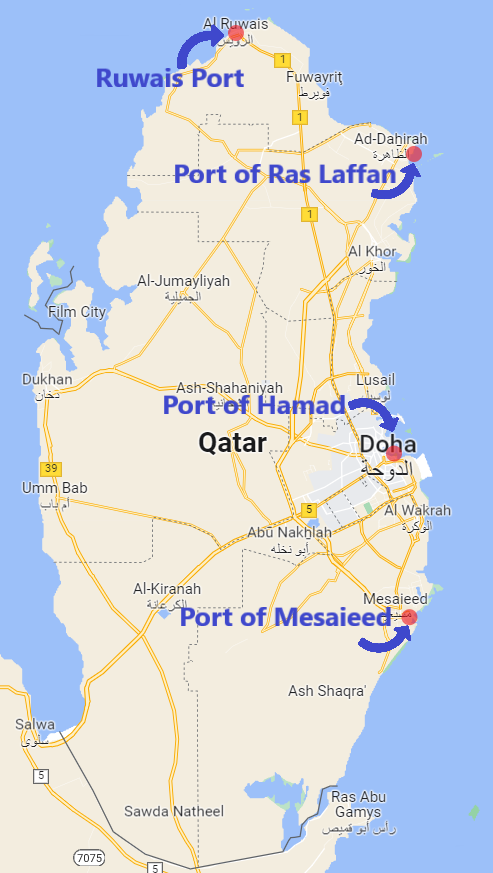
Nestled in the Persian Gulf, the nation-state of Qatar stands as a beacon of economic prowess, fueled by its robust petroleum, natural gas, and oil industries.
With one of the world’s highest GDPs, Qatar boasts a thriving economy that relies heavily on maritime trade facilitated by its state-of-the-art ports. Let’s embark on a journey to uncover the key players in Qatar’s maritime landscape.
- Port of Hamad/ Doha.
- Ras Laffan Port.
- Al-Ruwais Port.
- Port of Mesaieed/ Umm Said.
- Al Rayyan Marine oil Terminal Port.
- Al-Shaheen oil Terminal.
- Port of Halul Island
Port of Hamad/Doha:
At the forefront stands the Port of Hamad, strategically located south of Doha, Qatar’s capital. Its inception in 2016 marked a significant milestone, replacing the older Doha port. Managed by Mwani Qatar and overseen by the Ministry of Transport and Communications, Hamad Port serves as a bustling hub for various cargo, including livestock, vehicles, grains, and cereals.
Covering an impressive 29 kilometers, this port embodies Qatar’s vision for 2030, aiming to bolster economic diversification and international trade. Boasting an annual handling capacity of 7.5 million TEU and 1.8 million general cargo, Hamad Port is undergoing expansion to accommodate its burgeoning trade demands.
Ras Laffan Port:
Venturing to the northeast coast unveils Ras Laffan Port, a global heavyweight in LNG exports. This deepwater port stands as the world’s largest LNG exporting facility, fostering trade connections with major global players. Operated by Qatar Petroleum, Ras Laffan Port boasts state-of-the-art infrastructure, including berths equipped to handle massive LNG carriers and liquid bulk cargo.
With six LNG handling facilities and a dedicated terminal for sulphur, Ras Laffan Port exemplifies Qatar’s commitment to excellence in maritime trade. Its strategic location positions it as a vital link between the Arabian Gulf, the Far East, and Europe, facilitating the seamless transportation of hydrocarbon goods worldwide.
Al-Ruwais Port:
Turning our attention to northern Qatar, Al-Ruwais Port emerges as a key player in the region’s maritime trade landscape. Operated by Mwani Qatar, this port serves as a pivotal gateway for cargo shipments, revitalizing the economy of northern Qatar through increased trade volumes.
Beyond its role in conventional cargo handling, Al-Ruwais Port caters to the growing demand for fresh and refrigerated food, enhancing Qatar’s connectivity with neighboring nations. Infrastructural developments, including dredging the entrance channel and constructing new wharves, underscore Al-Ruwais Port’s commitment to meeting global port standards.
Port of Mesaieed/Umm Said:
Heading to Qatar’s eastern coast, we encounter Mesaieed Port, also known as Umm Said Port, a linchpin of Qatar’s industrial region. Handling a diverse array of goods, including crude oil, petrochemicals, and project cargo, Mesaieed Port plays a pivotal role in Qatar’s import and export activities.
With 29 operational berths catering to specific cargo types, Mesaieed Port exemplifies efficiency and versatility in maritime trade. Its strategic location, just 45 kilometers south of Doha, positions it as a vital conduit for Qatar’s trade endeavors.
Al Rayyan Marine Oil Terminal Port:
Nestled in the southern Persian Gulf lies the Al Rayyan Marine Oil Terminal Port, a crucial node in Qatar’s oil export infrastructure. Anchored by the Falcon Spirit storage tanker, this terminal facilitates the seamless transfer of crude oil to export tankers, bolstering Qatar’s position as a key player in the global oil market.
Al-Shaheen Oil Terminal:
Situated near the Shaheen oil field, off Qatar’s northeast coastline, the Al-Shaheen Oil Terminal stands as a testament to Qatar’s oil prowess. With 33 platforms and over 300 wells, this terminal plays a pivotal role in Qatar’s oil production, accounting for a significant portion of the nation’s output.
Port of Halul Island:
Finally, we arrive at the Port of Halul Island, an export terminal for Qatar Marine Crude oil. Operated by Qatar Petroleum, this facility boasts two Single Buoy Moorings (SBMs) that facilitate the efficient export of crude oil from Qatar’s northern oil fields.
As we traverse Qatar’s maritime landscape, it becomes evident that these ports are more than mere logistical hubs—they are the lifeblood of Qatar’s economy, driving prosperity and fostering global connectivity. From bustling commercial activities to strategic oil exports, Qatar’s major ports stand as testament to the nation’s unwavering commitment to maritime excellence.


Latest Products
2J55 Magnetron
M1568B Magnetron
MSF1422B Magnetron
CETC VAI8 AIS SART